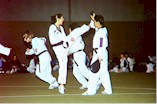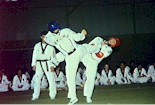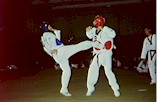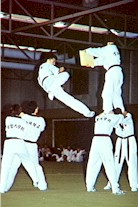 | ||
 |
||
|
| ||
 |
|||||||
Taekwondo Characteristics of the Sport Taekwondo featured as a full medal sport at the Sydney 2000 Olympics for the first time. It is characterised by high-intensity anaerobic activity interspersed with submaximal aerobic work. Taekwondo athletes need to rapidly generate muscular force in a quick series of punches and kicks. Aerobic endurance is required to assist with recovery between bursts of high-intensity activity and to support performance through several bouts in a tournament. Training Training for taekwondo primarily involves the development of technique and tactics. Athletes spend time practicing individual sequences as well as sparring. Taekwondo focuses on the development of the mind as well as the body and long hours of training are often required to develop concentration. Fitness work and gym sessions to develop strength and endurance may also be included in the training week. Competition Taekwondo competition consists of 3 by 3 minute rounds with 1 minute rest between each round. Competitors usually compete 3-5 times over a one day period in order to reach the finals of tournaments. While carbohydrate and fluid stores are unlikely to be taxed in a single taekwondo bout, athletes competing in a series of bouts in a tournament situation have the potential to stress carbohydrate and fluid stores. Recovery of carbohydrate and fluid between bouts is therefore important for continued good performance. Physical Characteristics The ability to propel the body through space as quickly as possible is essential to taekwondo competitors. A low body fat level helps athletes to accelerate as fast as possible so competitors aim to compete with the minimum amount of body fat to be successful. Taekwondo is held in weight categories, aiming to match opponents of roughly equal ability. however, it is advantageous to be at the upper end of the weight range within a weight category, since this suggests that among the athletes in your pool, you may be the biggest and strongest, and have the greatest reach. Consequently, the typical tactic among competitors is to 'downsize' just before the event to qualify for the lightest weight category that can be achieved. Thus, like other weight division sports, 'making weight' strategies are a feature of taekwondo. Weight categories for males are <58kg, 58-69kg, 69-80kg and >80kg. Weight categories for females are <49kg, 49-57kg, 57-67kg and >67kg. Common Nutrition Issues Body Fat Levels & Body Weight IssuesLike many athletes who compete in weight category sports, many taekwondo athletes become focused on achieving low body fat levels, and achieving weight losses before competition to allow them to qualify in their chosen (lower) weight category. This emphasis on weight control, often for very targeted periods, often overshadows other nutrition goals. Nutrition patterns can easily fall into a cycle of severe food restriction leading up to a competition, followed by bingeing afterwards. This cycling can lead to swings in body mass (weight) and body fat levels, as well as failure to achieve nutritional needs in the long-term. The Training Diet – Week-round Recovery Athletes will get the most out of each training session if they are adequately fuelled and hydrated. The focus of the overall eating plan should be nutritious carbohydrate-rich foods such as pasta, rice, bread, fruit, and flavoured dairy products which will provide the muscles with their training fuel. Moderate amounts of low fat protein sources such as lean meat, lean poultry, fish, eggs and vegetarian sources should be added to these foods to balance the meal, as well as additional fruit and vegetables to provide vitamin and mineral needs. Overall, the athlete needs to have their training under-pinned by a nutrition plan that provides all their nutritional needs, while allowing them to gradually achieve and maintain a lean physique suited to their weight category. Meals and snacks should be timed over the day to allow the athlete to fuel up before each training session, and refuel/ recover afterwards. Where there is a long gap between meals and a training session - for example, between lunch and a late afternoon training session, it is useful to have a carbohydrate-based snack 1-2 hours before training to 'top-up' and prevent hunger. Examples of practical snacks include fruit and yoghurt, a bowl of cereal, and toast with a milk smoothie or hot milk drink. Speedy intake of carbohydrate-based foods teamed with a protein source, will help to promote refueling after training, as well as muscle repair and growth. If it isn't practical to have a main meal within 30-60 minutes after training, a snack providing 50-100 grams of carbohydrate and a source of protein, is a good choice as a recovery aid. Recovery snacks should be combined with fluid to replace any fluid lost during the session.
Ma king Weight in TaekwondoIt is advantageous for taekwondo competitors to compete at the upper limit of weight categories. Typically, a 72kg male will be more competitive if he can drop a couple of kilograms and compete in the 69kg division, rather than fight at a weigh that is towards the bottom of the 80kg division against much heavier opponents. However, athletes need to choose their weight categories based on competition goals, growth stage, skinfold history and minimal weight for good health, In the long-term, the choice of weight category should be consistent with good health as well as good performance. In general, athletes should aim to keep body weight within 2-3kg of the upper weight limit for their weight category. This means that the need to 'make weight' before competition will be kept within a practical and manageable target. Athletes should work with a dietitian to reduce body fat levels and maintain weight at a suitable level. Young athlete should also be prepared to move up into higher weight categories in accordance with their growth changes. There are a number of tactics that can be undertaken in the last days before a competitive event to help to 'fine tune' body mass. In the 2-3 days prior to competition, athletes should avoid excessive salt intake, to prevent fluid retention. Adopting a low residue diet for the last 24 hours before competing will help to reduce weight further, since it empties the gut of indigested food and fibre. Depending on their size and typical diet, most people carry about 0.5-1kg of such material in their gut during the day. Fasting will allow this food to be processed and eliminated, and cause a 'technical' weight loss. However, it will also prevent the athlete from fuelling up before their event. On the other hand, a low-residue diet composed of nutritious foods with minimal fibre or waste product will provide nutritional goals while being 'light' to eat.
Traditionally, competitors use extensive dehydration to lower body weight prior to competition. Excessive dehydration can adversely affect performance and increase the risk of heat stress. It is smarter for competitors to manipulate food intake, then passively dehydrate over the day before competition. Passive dehydration involves limiting fluid intake while undertaking normal daily activities. Remember that approximately 500g will be lost overnight as you sleep due to passive fluid losses. Use of saunas, sweat suits etc. should not be necessary if you have planned your preparation well. After the Weigh-In Taekwondo events usually require competitors to weigh in on the morning of competition. This allows very little time to restore inadequate fuel and fluid levels after weigh-in, placing the emphasis on good preparation rather than trying to recover after extreme weight-making tactics. Sports drink are a suitable choice between weigh-in and competition to top up fluid levels. Liquid meals, sports bars or cereal bars and confectionery may also be used for additional fuel. These choices are also suitable between each bout in a tournament. Case Study Max was a talented taekwondo competitor on the fringe of making the national team. He had plenty of talent but was finding it harder and harder to make his weight category of 69kg. Max found it stressful cutting back on food prior to competing, especially when his friends were eating pizza in front of him. He was relying on dehydration to a greater extent to make-weight, but was finding this sapped his energy levels. His performance was suffering and Max was consoling himself after competition with binges on pizza and any other high fat food he could lay his hands on. max had seen other competitors go down the path he was heading and decided something had to be done. Max consulted a sports dietitian. The first investigation undertaken by the sports dietitian, was an assessment of Max's 'skinfold levels', and thus his potential to change his body weight by losing body fat. At his 'training weight' of 75-6kg, Max's skinfolds were found to be 67mm for a sum of seven sites - good potential for reduction without compromising health and training performance. The dietitian advised Max that if he reduced his body fat level over the long term, he would be closer to his weight category and could avoid relying on dehydration to reduce weight. The dietitian and Max negotiated a meal plan which provided adequate carbohydrate to fuel training sessions and adequate protein to minimise loss of muscle mass. Max learnt that by keeping his fat intake low, satisfying quantities of foods could be eaten each day and Max didn't have to feel uncomfortably hungry. By making his own pizza and being smart with topping selections, Max's favourite food could also be included. Over two months, Max gradually dropped his skinfolds to 50mm and was able to maintain his weight at 72kg. At this weight, max could easily drop back to 69kg for competition by cutting back on snacks one week prior to competition, following a low residue diet for 24 hours and passively dehydrating the night before. Although some sacrifices and organsiation were required, spreading the effort over the long term was found to be less stressful than the worry of "will I make the weigh-in target" before each competition. it also left him feeling confident and well-prepared after the weigh-in, instead of drained and dry. Look out for Max competing for the national team in the future.
|
| ||||||
|
The Department of Sports Nutrition is a program of the
Australian Institute of Sport General enquires can be emailed to: aisnutrition@ausport.gov.au Copyright
© Australian Sports Commission
| |||||||




